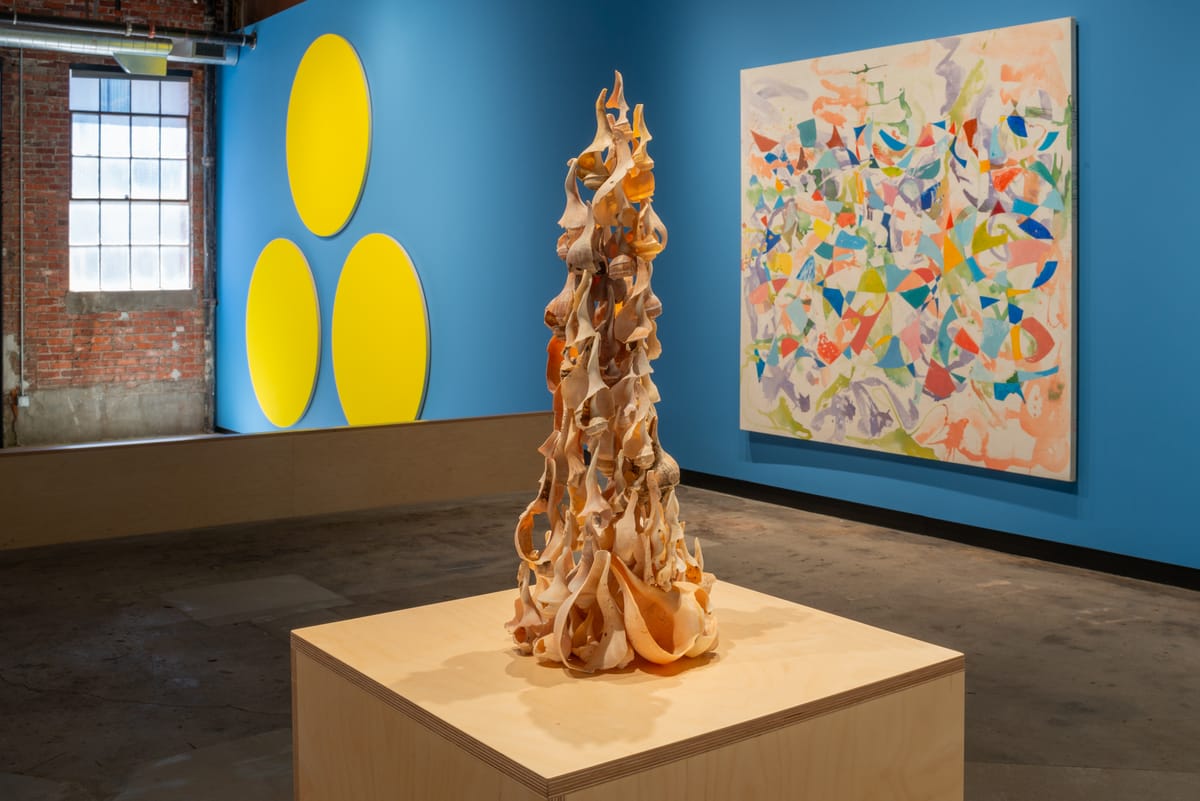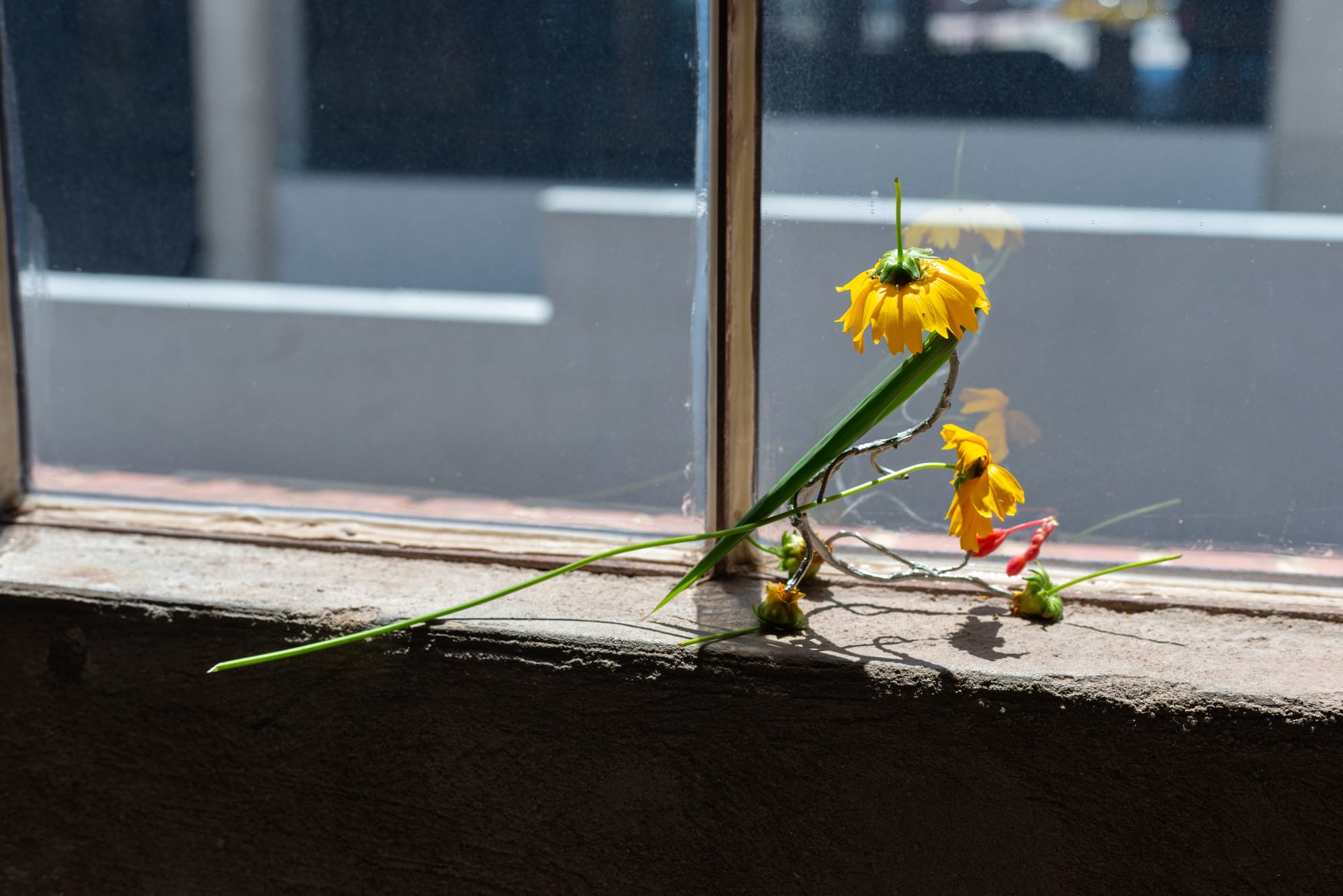
Presented by the Tulsa Artist Fellowship in its Flagship space June 6 through Aug. 9, Spatial Poems offers a special opportunity for Tulsa Artist Fellowship recipients, Tulsa residents and the broader art community to see complex and dynamic work that has never been exhibited in the city before.
To challenge the audience’s method of perception and push beyond frameworks of passive art consumption, curator and art historian Cassidy Petrazzi selected works from six contemporary, internationally known artists to support her thesis of Spatial Poems: Art happens in the encounter with life.
“The separation between art and life can be collapsed in a way that we often don’t fully experience in our everyday lives – and that is something as simple as looking out your car, window as you’re driving or cooking food with other people. These can be really sacred and creative acts,” says Petrazzi.
You’re invited to Spatial Poems to not consume the art.
Without the support of the Tulsa Artist Fellowship and use of its space, this exhibit may not have come to pass. The Fellowship’s Executive and Artistic Director Carolyn Sickles is proud to provide an anchoring location for the art scene in Tulsa via Flagship.
While Flagship began pre-pandemic as a “living room for the Tulsa Artist Fellowship,” post-pandemic, Sickles, her team and fellows didn’t want it to just be about the fellowship, so they sought to create a multi-platform community-driven space.
“That’s very indicative of the way the Fellowship kind of exists as a whole. It’s about the people, the needs that they have on their plate and how we all collectively want to use the [Flagship] space and make it something that can be a resource for a Tulsa-based curator like Cassidy,” says Sickles.

In Flux
Spatial Poems has been long in the making, with at least two years of work to bring it to fruition. This isn’t counting the research work Petrazzi did while writing her master’s thesis in art history about Alison Knowles, a founding member of the Fluxus art movement of the 1960s and ’70s.
As Petrazzi explains, Fluxus sought to bring “a group of artists together and work under a certain name and philosophy of anti-commodification, open, indeterminate pieces that are really open to participation, performance and interpretation.” One common medium of Fluxus artists was that of the performance score, essentially instructions directing the reader or participant to perform an action as art.
So while Spatial Poems does not have any works by Fluxus artists within it, it’s an excerpt of Mary Lucier’s Fluxus performance score “Media Sculptures: Maps of Space #1 and #2,” published in Womens Work (1975) that serves as the literal and figurative guideposts for Petrazzi’s selections of the art in the exhibit and how she wanted audiences to interact with it.
“Select an image of an environment. Concentrate on this image, discovering all the circles, squares or triangles in it, until either the original scene is obliterated or an entirely new landscape emerges, or until your mind can no longer hold all the information.” — Mary Lucier
However, to prevent any type of prescriptivist approach to the exhibit, Petrazzi eschewed vinyl lettering that explained Lucier’s score, to allow viewers room to explore on their own terms. Same with the interior walls that formerly divided the Flagship space: No walls in the space means the viewer has no externally dictated path and has to create their own.
Petrazzi does admit that Olivier Mosset’s “Untitled (Yellow Tondos),” displayed on a non-white wall — the wall’s blue color taken from the masthead of Womens Work — presents an anchoring point that stops viewers in their tracks.
“So often, and I’m even guilty of this too, you walk into a gallery, people kind of rush through things — plus attention is much shorter than it’s ever been,” posits Petrazzi, “And I think kind of shifting the color and the space and the way that it enhances some of the paintings, for me, is a cue to slow down and look in a different way.”

In Conversation
While the audience is encouraged to be in dialogue with each individual work of art, the exhibit is also designed to be in dialogue as a whole — emerging as a landscape in its own right.
Mitchell Algus’ evocation of the organic through his oil paintings and seashell sculptures is near Peter Young’s commanding, abstract oil paintings with similar color values and tones. The ellipses and shapes in Young’s paintings are mirrored in the motorized moving photos of Tulsa-based Tulsa Artist Fellowship alumni Shane Darwent.
Umico Niwa’s whimsical metal and organic plant sculptures are tucked in unexpected corners like the windowsill, or hung from the ceiling, or hidden in structural elements. Even Niwa’s philosophy toward these sculptures works toward the show’s thesis — with each exhibition, the curator works with Niwa to source fresh flowers and determine the spatial placement of each sculpture in the room.
The time-based video art of Julia Calabrese, including one piece commissioned specifically for the exhibit, reacts to the Lucier score and serves as a nice contrast next to Mosset’s “Untitled (Rauschenberg White),” a canvas painted with prominent brushstrokes using the eponymous white tone. This painting seems to be the closing punctuation toward the energetic end of the exhibit — what happens when the original scene is obliterated, like Lucier instructs.
And to finally epitomize how the exhibition space will continue to transform throughout the exhibition, an edition of Mosset’s well-known ice sculptures, “ICE III,” will be delivered to the Flagship alley space on June 6. Petrazzi hopes that audiences will feel the exhibit is “fresh and alive,” but all reactions and perceptions are welcome.
“I hope it’s work that they feel excited by and that there’s some sort of a reaction, whether it’s emotional or even if someone has a negative reaction,” says Petrazzi. “I think any reaction actually is good with art. You want someone to feel something about the work coming away from it.”
And through the lens of Spatial Poems, it’s the audience’s feelings and perceptions that complete these pieces.
Spatial Poems opens June 6 and runs through Aug. 9 at Tulsa Artist Fellowship Flagship, 112 N. Boston Ave., Tulsa. For more information, visit tulsaartistfellowship.org or follow Tulsa Artist Fellowship on Instagram at @tulsaartistfellowship.

